
Source: Jishi Communication
summary
In the early days, the cryptocurrency market was accustomed to Bitcoin’s bull and bear market strictly following the halving cycle every four years, but as Bitcoin continues to integrate with the US dollar market, the impact of US dollar liquidity has become an issue that cannot be ignored.Looking at the liquidity of the US dollar in the long term, the impact of AI on the capital market cannot be ignored in the short term.The market has been under multiple changes recently: 1) The US rate cut will be in the future and in the future; 2) The impact of the increased probability of Trump’s election on sentiment; 3) The half-year consolidation period after the halving; 4) The flow released by the pullback of the US stock technology sector.This article regards BTC as a global all-weather risk asset to discuss its fluctuations before and after the inflection point of interest rate cuts and before and after the halving.
As for the first three halvings, it seems that the halving cycle and the bull and bear cycle are mechanically perfect.Perhaps because of this experience, halving has become the most concerned time point in the industry.However, the fourth halving has broken this law to some extent. Although the time is close to the fourth halving, before this halving, Bitcoin price catalyzed by ETFs and other factorsIt has already hit a new high, which is the most obvious difference from the first three halving times.
In terms of macro factors, US dollar liquidity has gradually become the main long-term factor affecting Bitcoin price.Bitcoin2009Since the birth of 2019, the relationship between the early Bitcoin bull-bear conversion and the actual yield of US Treasury bonds has not been significant, and it even seems to be unrelated.2015The year begins,The (negative correlation) law has a slight prototype.2018Since the beginning of the year, the negative correlation between the two has begun to increase,2020Starting from the beginning of the year, we can roughly see that the relationship between the two began to gradually emerge, that is, in the environment of low interest rates, the market performance of Bitcoin is better.This is also consistent with the significant positive correlation between Bitcoin and the Nasdaq since 2020.in additionFeatures that can be seenyes:At the beginning of the inflection point of interest rate decline, Bitcoin is often in a phase of oscillating adjustment, andThe main rising trend of Bitcoin often occurs in interest ratesIn the stage of a lower level threshold.The turning point of interest rates can easily lead to the turning point of currency price going from bull to bear.
Bitcoin spot ETFs have created a local “disturbance” for the market from the perspective of capital.In October 2023, the market began to speculate on the expectations of Bitcoin spot ETF approval and the continued capital inflow after approval in January 2024. Bitcoin started a wave of rising main rising market, which happened against the backdrop of US dollar interest rate hikes.In the stage when the actual yield of US Treasury bonds rises, the two have a positive correlation.Therefore, we can think that the huge amount of funds brought by ETFs “breaks” the simple rules of the past, which is equivalent to creating a “disturbance” locally.In recent years, as ETFs stabilized at the scale of US$50 billion and the actual yield of US bonds is in a high fluctuation operation stage, the currency price has entered the adjustment stage.
Referring to the previous experience, we speculate that the next turning point of interest rate cuts, the Bitcoin price may still be in the volatile stage, and the next main rising trend of Bitcoin should occur in the middle and late stages of the interest rate cut cycle – that is, the interest rate runs in a relativeStable low stage.
In the short term, market trading CPI expectations are also an interesting phenomenon.We observe the relationship between the US CPI data and Bitcoin price performance every month since 2018. We expect that the CPI value minus the published data value (we call inflation cooling value) to be positive, which means that inflation has signs of cooling.Rate cuts (enhanced market liquidity) are a positive signal.Therefore, examining the relationship between the price rise and fall of Bitcoin on the day (even at that time) and the cooling value of inflation can reflect market trading expectations.From the data below, we can see that when the published CPI data is reflected in the inflation cooling value being the right time Bitcoin rises and closes on the day (time), especially after 2020, this situation is more frequent.This phenomenon can be called trading CPI expectations. This short-term trading strategy has certain effectiveness. Even if Bitcoin went from a high level in 2022, the year of interest rate hikes, the inflation cooling value was positive several times.In the case, Bitcoin often appears to rise on the day.
Risk warning:The research and development of blockchain technology is lower than expected; the uncertainty of regulatory policies; the implementation of the Web3.0 business model is lower than expected.
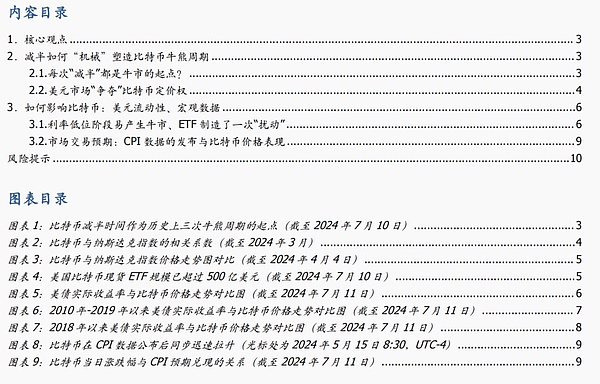
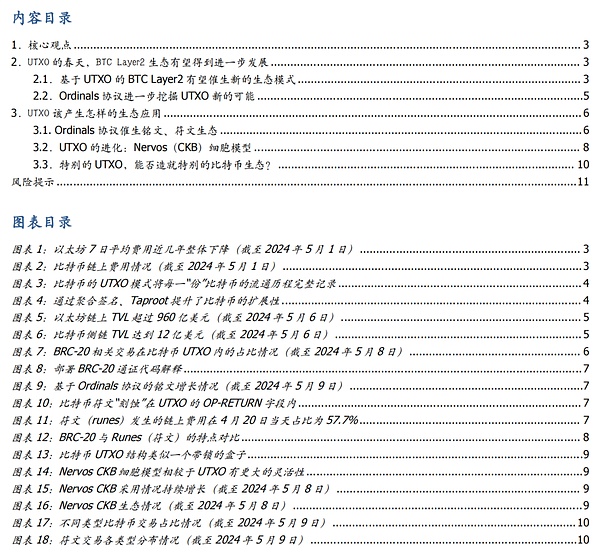
1. Core viewpoint
In the early days, the cryptocurrency market was accustomed to Bitcoin’s bull and bear market strictly following the halving cycle every four years, but as Bitcoin continues to integrate with the US dollar market, the impact of US dollar liquidity has become an issue that cannot be ignored.
Bitcoin entered the US futures market in December 2017, Tesla purchased Bitcoin in 2021, and the US SEC approved Bitcoin spot ETF in January 2024. Against this background, after Bitcoin entered the US capital market, it was subject to US dollar liquidity.The impact is becoming more and more obvious.From the early market to the present, the main factors affecting Bitcoin prices have been changing.
We use the actual yield of US Treasury as an observation indicator of market capital liquidity, and combine the impact of US CPI data on market expectations to analyze the relationship between Bitcoin and these two variables.
2. How to “mechanically” shape Bitcoin bull and bear cycles in halving
2.1 Every “halving” is the starting point of a bull market?
We know that the output rule of Bitcoin is to halve every four years. It has experienced halvings since 2009. The fourth halving was completed on April 20, 2024 – this is to write the Bitcoin codemechanical action.From 2009 to 2021, Bitcoin experienced three rounds of bull and bear market conversion. Each market was innovative in the industry (namely, the emergence of Bitcoin competitors, the preliminary exploration of industry applications driven by Ethereum smart contracts, and DeFi/yuan.Innovation brought by innovative applications such as the universe) is the main line of hype; but an interesting coincidence is that the 4-year halving cycle (not considering the fourth halving just experienced for the time being) is also the Bitcoin market turning upward from the bottom of the bear market.Starting point area – In other words, the first three halving times correspond to the starting point of the three bull and bear cycles. In fact, the industry often regards the “halving time point” as the “experience benefit” for the start of the bull market.
It should be noted that, judging from the first three halving times, compared with the previous wave of the top, its price is at a significant bottom. The next new round of top backtesting seems to be the starting point of this round of market conditions..

As for the first three halvings, it seems that the halving cycle and the bull and bear cycle are mechanically perfect.Perhaps because of this experience, halving has become the most concerned time point in the industry.However, the fourth halving has broken this law to some extent. Although the time is close to the fourth halving, before this halving, the price of Bitcoin has hit a new high., this is the most obvious difference from the first three halving times.
2.2 The US dollar market “fights” for Bitcoin pricing rights
Bitcoin entered the US futures market in December 2017, Tesla purchased Bitcoin in 2021, and the US SEC approved Bitcoin spot ETF in January 2024. Against this background, after Bitcoin entered the US capital market, it is more reflected inThe attributes of technological innovation and high-risk attributes are therefore showing an increasingly positive correlation with the Nasdaq.
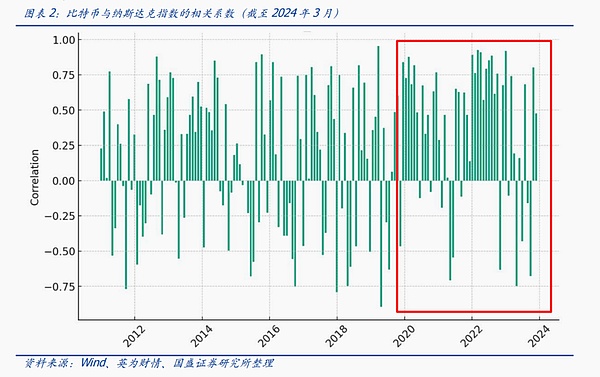
Back to the micro level, comparing Bitcoin with the Nasdaq chart, it was reflected in the oscillation between 2018 and 2021, and in mid-to-late November 2021, both reached an all-time high, and the subsequent adjustments were made.Both reached an adjusted low between October and November 2022, and their subsequent trends have hit record highs so far.The two showed an increasingly higher positive correlation.
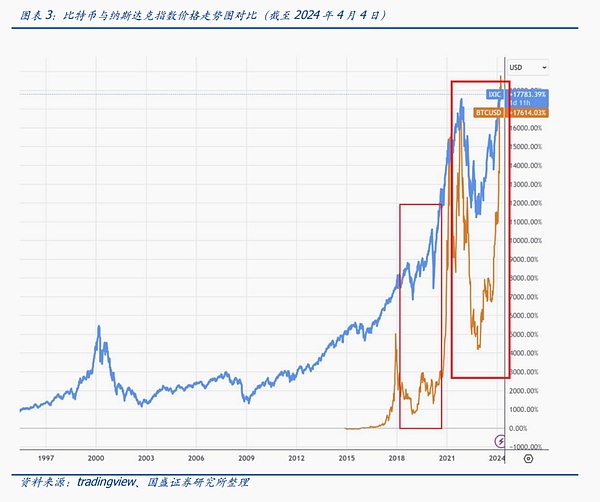
An interesting view and idea: There are currently 7 most important weight stocks in the Nasdaq (Microsoft, Apple, Alphabet, Nvidia, Amazon, META and Tesla, etc.), and Bitcoin is more like the 8th important weight of the Nasdaq.This view does not have a strict logical basis, but Bitcoin’s technological innovation and high-risk attributes have many similarities with these seven companies, not to mention that the correlation between price trends actually confirms this.In addition, with the listing of Bitcoin ETFs, Bitcoin, an alternative asset, is directly connected with the US stock market, which to a certain extent has also strengthened the US stock market’s pricing ability.
Especially Bitcoin spotETF,since1moon11Daily spotETFgetSECSince approval, so far (2024Year7moon10day)6In months, its scale has expanded rapidly to500The level of $100 million is an amazing growth rate.The continuous large amount of funds rushing to stock in the market may be an important reason why Bitcoin has experienced historical high innovations before the fourth halving.
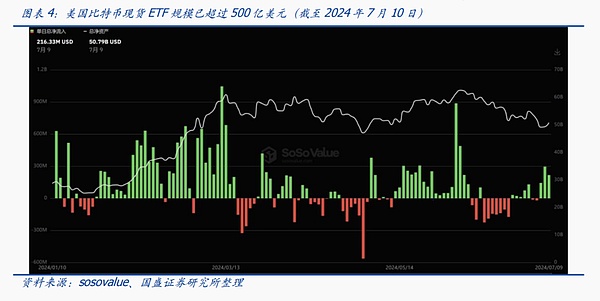
As US market funds have become increasingly impacted on Bitcoin, what will the mechanical laws of the halved four-year bear market cycle be impacted?
This is a complex issue. Over the past period of time, the blockchain industry has been increasingly concerned about the US macro data and the Federal Reserve’s interest rate decisions – from another perspective, the US dollar tide has begun to “sway” the expectations of the cryptocurrency market.Therefore, we will observe Bitcoin’s price performance from factors such as the US dollar tide, US macro data and the Federal Reserve’s interest rate resolution, and try to explore the rules and logic.
3. How to affect Bitcoin: US dollar liquidity, macro data
3.1. The low interest rate stage is prone to generate a bull market, and ETFs create a “disturbance”
In terms of macro factors, US dollar liquidity has gradually become the main long-term factor affecting Bitcoin price.In terms of macro factors, we use the actual yield of US bonds as an observation indicator of market capital liquidity.Bitcoin2009Since the birth of 2019, the relationship between the early Bitcoin bull-bear conversion and the actual yield of US Treasury bonds has not been significant, and it even seems to be unrelated.2015Starting from the year, the (negative correlation) laws of the two have taken a slight prototype.2018Since the beginning of the year, the (negative) correlation between the two has begun to increase,2020Starting from the beginning of the year, we can roughly see that the relationship between the two began to gradually emerge, that is, in the environment of low interest rates, the market performance of Bitcoin is better.This is also consistent with the significant positive correlation between Bitcoin and the Nasdaq since 2020.
In addition, the characteristics that can be seen are: at the turning point stage of interest rate decline, Bitcoin is often in the oscillating adjustment stage, and the main rising market of Bitcoin often occurs in the stage where interest rates are at a low level (recently due to BitcoinETFApproved to listing will cause certain disturbances, we will analyze it later).The turning point of interest rates can easily lead to the turning point of currency price going from bull to bear.
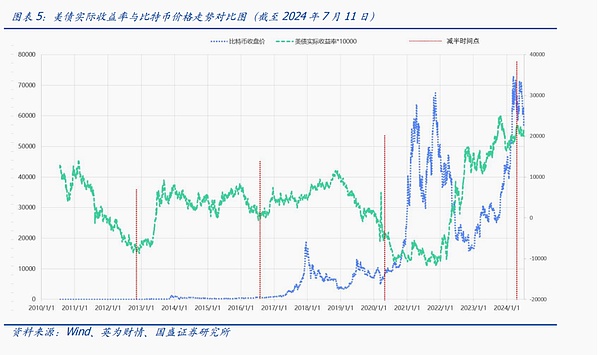
From the details, the real yield of US bonds also rose in the first bull market in 2013. At this time, the cryptocurrency market was still in a “chaotic” and naive stage, and it is difficult to explain the capital components clearly. BitcoinThe relationship between price and macroscopy is more difficult to analyze clearly – this stage can be called the “grassroots stage” of the cryptocurrency market.The main upward trend from 2016 to 2018 is the main background of the industry entering the second halving and the Ethereum project was born. Its smart contract capabilities bring new means of rapid financing in the industry – namely ICO (Initial Coin Offering), and what follows is the continuous inflow of external funds.We believe that at the beginning of this stage, part of the inflow of funds may come from the traditional capital market, so the macro environment and liquidity begin to have an impact on Bitcoin prices.As can be seen from the figure below, this wave of main upward trend in 2017 was accompanied by the period of low fluctuation of interest rates. The subsequent interest rate rose, and the market peaked and turned to a bear (in the purple box).That is, the interest rate is stable at a certain low level, which is conducive to the bullish market. This may be understood as the liquidity is abundant in the low level of interest rate, and liquidity spills out to the cryptocurrency market, driving Bitcoin price to the main upward stage.
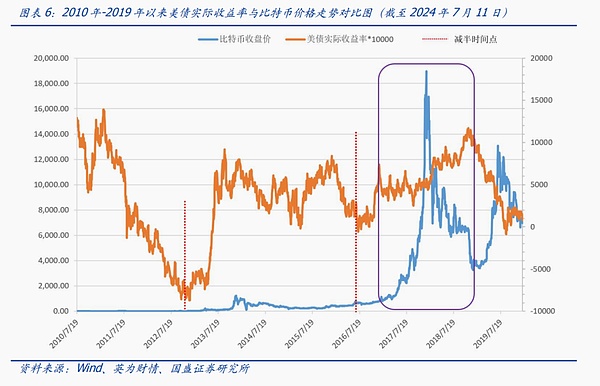
from2018Judging from the trends since the beginning of the year, the actual yield of US bonds is negatively correlated with the trend of Bitcoin.Especially at the end of 2021, Bitcoin fell from its high point and the market became bearish. At this time, the US dollar started a cycle of interest rate hikes. The actual yield of US bonds began to turn upward, which also brought the price to the top and bearish.the turning point.
But in the purple circle in the picture below, the market began to speculate on the expectations of Bitcoin spot ETF approval in October 2023 and the continued capital inflow after approval in January 2024. Bitcoin started a wave of rising main upward trend, which happened inAgainst the backdrop of US dollar interest rate hikes, the two have shown positive correlations in the stage when the actual yield of US bonds rises.Therefore, we can think that the huge amount of funds brought by ETFs “breaks” the simple rules of the past, which is equivalent to creating a “disturbance” locally.In recent years, as ETFs stabilized at the scale of US$50 billion and the actual yield of US bonds is in a high fluctuation operation stage, the currency price has entered the adjustment stage.
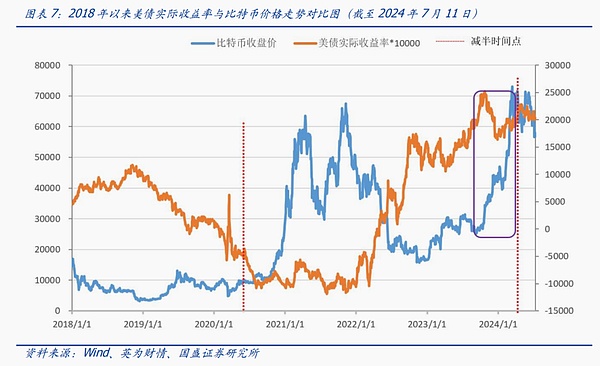
From this we can see thatAt the macro level, we can use an analysis method that compares market interest rates and Bitcoin price trends. Bitcoin is affected by the macro environment and its own capital logic is also an important short-term factor.The expectations of Bitcoin spot ETFs that began to be hotly speculated in October 2023 and the continued capital inflow after the ETF was approved for listing in January 2024 have led to a rapid and sharp rise in Bitcoin during this period.After hitting a record high on March 14 this year, Bitcoin began to enter a volatile adjustment stage. During the interest rate hike cycle, when the expectation of interest rate cuts is not very clear, the constraints of macro liquidity have become the main external force of the market.
Referring to the previous experience, we speculate that the price of Bitcoin may still be in a fluctuating stage at the next turnover point of interest rate cuts, and the next main rising trend of Bitcoin should occur in the middle and late stages of the interest rate cut cycle.——That is, interest rates are running at a relatively stable low stage.
Next, we try to observe the impact of short-term market expectations (taking CPI data as the entry point) on Bitcoin price from the perspective of market trading expectations.
3.2 Market transaction expectations: release of CPI data and Bitcoin price performance
Since Bitcoin entered the CME futures market in December 2017, Bitcoin has gradually integrated with the US dollar market.The relationship between Bitcoin price performance and the US dollar market is complicated. Looking at the historical trend of Bitcoin, Bitcoin’s short-term price performance is often very sensitive to US macro data and policies, especially the time when the CPI data is released and the Federal Reserve announced its interest rate resolution.Bitcoin often has a relatively obvious performance.For example, on May 15, 2024, the United States released April CPI data (released at 8:30 local time, time zone is UTC-4) showing that inflation has cooled down. Almost at the same moment, the price of Bitcoin rose rapidly, with an increase of more than 7% on the same day..It can be simply understood that inflation cooling is a marginal positive signal during the US dollar interest rate hike cycle, indicating an increase in the probability of liquidity turning to easing, so the market is trading this expectation.
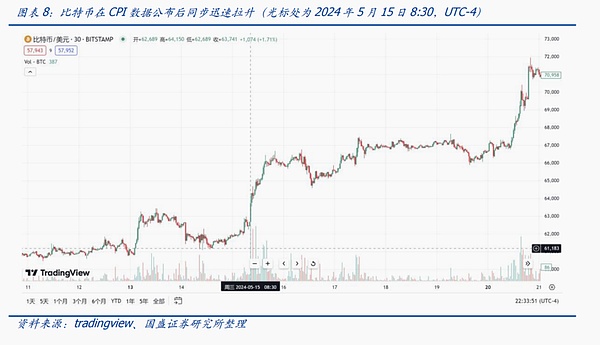
We observe the relationship between the US CPI data and Bitcoin price performance every month since 2018. We expect that the CPI value minus the published data value (we call inflation cooling value) to be positive, which means that inflation has signs of cooling.Rate cuts (enhanced market liquidity) are a positive signal.Therefore, examining the relationship between the price rise and fall of Bitcoin on the day (even at that time) and the cooling value of inflation can reflect market trading expectations.From the data below, we can see that when the published CPI data is reflected in the inflation cooling value being the right time Bitcoin rises and closes on the day (time), especially after 2020, this situation is more frequent.
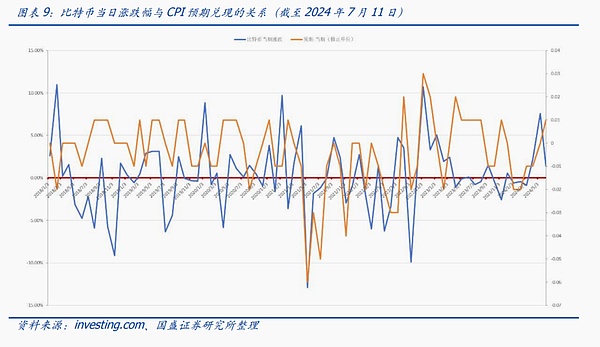
This phenomenon can be called trading CPI expectations. This short-term trading strategy has certain effectiveness. Even if Bitcoin went from a high level in 2022, the year of interest rate hikes, the inflation cooling value was positive several times.In the case, Bitcoin often appears to rise on the day.
As an alternative asset for global all-weather trading, BTC’s spot and derivatives trading scale is increasing, becoming an excellent window to observe global macro fluctuations. In the latter stage, the actual rate cut progress, Trump’s attitude towards BTC, and global geopolitics.Changes and other factors will become factors that affect BTC price fluctuations.
Risk warning
Blockchain technology research and development is not as expected: Bitcoin’s underlying blockchain-related technologies and projects are in the early stages of development, and there is a risk that technology research and development is not as expected.
Uncertainty of regulatory policies: The actual operation of blockchain and Web3.0 projects involves a number of financial, network and other regulatory policies. At present, regulatory policies in various countries are still in the stage of research and exploration, and there is no mature regulatory model.Therefore, the industry faces the risk of uncertainty in regulatory policies.
The implementation of the Web3.0 business model is less than expected: Web3.0-related infrastructure and projects are in the early stages of development, and there is a risk that the implementation of the business model is less than expected.
This article is excerpted from the report “Blockchain: How Do U.S. Tides and Halfing Impact Bitcoin?》, please refer to the relevant report for details.








